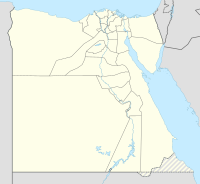Kibrit Air Base: Difference between revisions
edited |
edited and expanded |
||
| Line 47: | Line 47: | ||
'''Kibrit Air Base''' is a closed [[Egyptian Air Force]] ({{lang-ar|القوات الجوية المصرية}}, ''{{transl|ar|DIN|Al-Qūwāt al-Gawwīyä al-Miṣrīyä}}'') base located in [[Egypt]], approximately 20 miles north of [[Suez]]; 125km east of [[Cairo]]. The name of the station came from a nearby village, and in Egyptian means "light". |
'''Kibrit Air Base''' is a closed [[Egyptian Air Force]] ({{lang-ar|القوات الجوية المصرية}}, ''{{transl|ar|DIN|Al-Qūwāt al-Gawwīyä al-Miṣrīyä}}'') base located in [[Egypt]], approximately 20 miles north of [[Suez]]; 125km east of [[Cairo]]. The name of the station came from a nearby village, and in Egyptian means "light". |
||
During [[World War II]] the facility was known as RAF Station Kabrit, and was a major [[Royal Air Force]] facility which was used during the [[Western Desert Campaign]] by the RAF and the [[United States Army Air Forces]]. |
|||
== History == |
== History == |
||
During [[World War II]] the facility was known as RAF Station Kabrit, and was a major [[Royal Air Force]] facility which was used during the [[Western Desert Campaign]]. In 1941, it was where the [[Special Air Service]] (SAS) was formed. Beginning in 1942, [[United States Army Air Force]] [[Ninth Air Force]] units arrived to supplement the RAF against the Germans in the Western Desert. After the war, Karbit remained a RAF station until the breakdown in relations between the British and Egyptian governments in 1956 when the decision was taken to pull out British forces from the Canal Zone. |
|||
The base was taken over by the Egyptian Air Force and renamed "Kibrit", becoming one of its main air bases. During the 1956 Suez Crisis, it was a base for the EAF 20 Squadron, equipped with twelve Soviet-built [[Mig-15]] aircraft. During the [[Six-Day War|1967 Arab-Israeli War]], the base was attacked by the [[Israeli Air Force]], and many of it's Soviet-built [[Mig-17]] aircraft were destoryed on the ramp by the IAF's [[Dassault Mystère IV]]s. In the [[Yom Kippur War|1973 Yom Kippur War]] with Israel, the airfield was captured by Israeli ground forces that crossed the [[Suez Canal]] along with Kasfreet and Shalufa Air Bases, however it was not used by the Israeli Air Force. |
|||
Currently, the airfield is closed and not on the EAF's current order of battle as being an active base. Its main runways are having their asphalt removed and it is unclear what the future holds for the airfield. |
|||
=== Operational units and aircraft === |
=== Operational units and aircraft === |
||
Revision as of 21:37, 10 October 2009
RAF Station Kabrit | |||||||||||||||
|---|---|---|---|---|---|---|---|---|---|---|---|---|---|---|---|
| Summary | |||||||||||||||
| Airport type | Military | ||||||||||||||
| Owner | Egyptian Air Force | ||||||||||||||
| Operator | Closed | ||||||||||||||
| Standort | Kabrit, Egypt | ||||||||||||||
| Elevation AMSL | 1,560 ft / 475 m | ||||||||||||||
| Coordinates | 30°14′45.40″N 032°29′24.12″E / 30.2459444°N 32.4900333°E | ||||||||||||||
| Runways | |||||||||||||||
| |||||||||||||||
Kibrit Air Base is a closed Egyptian Air Force (Arabic: القوات الجوية المصرية, Al-Qūwāt al-Gawwīyä al-Miṣrīyä) base located in Egypt, approximately 20 miles north of Suez; 125km east of Cairo. The name of the station came from a nearby village, and in Egyptian means "light".
History
During World War II the facility was known as RAF Station Kabrit, and was a major Royal Air Force facility which was used during the Western Desert Campaign. In 1941, it was where the Special Air Service (SAS) was formed. Beginning in 1942, United States Army Air Force Ninth Air Force units arrived to supplement the RAF against the Germans in the Western Desert. After the war, Karbit remained a RAF station until the breakdown in relations between the British and Egyptian governments in 1956 when the decision was taken to pull out British forces from the Canal Zone.
The base was taken over by the Egyptian Air Force and renamed "Kibrit", becoming one of its main air bases. During the 1956 Suez Crisis, it was a base for the EAF 20 Squadron, equipped with twelve Soviet-built Mig-15 aircraft. During the 1967 Arab-Israeli War, the base was attacked by the Israeli Air Force, and many of it's Soviet-built Mig-17 aircraft were destoryed on the ramp by the IAF's Dassault Mystère IVs. In the 1973 Yom Kippur War with Israel, the airfield was captured by Israeli ground forces that crossed the Suez Canal along with Kasfreet and Shalufa Air Bases, however it was not used by the Israeli Air Force.
Currently, the airfield is closed and not on the EAF's current order of battle as being an active base. Its main runways are having their asphalt removed and it is unclear what the future holds for the airfield.
Operational units and aircraft
See also
References
- Jefford, Wing Commander C.G., MBE,BA,RAF (Retd). RAF Squadrons, a Comprehensive Record of the Movement and Equipment of all RAF Squadrons and their Antecedents since 1912. Shrewsbury, Shropshire, UK: Airlife Publishing, 2001. ISBN 1-84037-141-2.
![]() This article incorporates public domain material from the Air Force Historical Research Agency
This article incorporates public domain material from the Air Force Historical Research Agency
- Maurer, Maurer. Air Force Combat Units of World War II. Maxwell AFB, Alabama: Office of Air Force History, 1983. ISBN 0-89201-092-4.
- Mauer, Mauer (1969), Combat Squadrons of the Air Force, World War II, Air Force Historical Studies Office, Maxwell AFB, Alabama. ISBN 0892010975
- Royal Air Force Airfield Creation for the Western Desert Campaign



